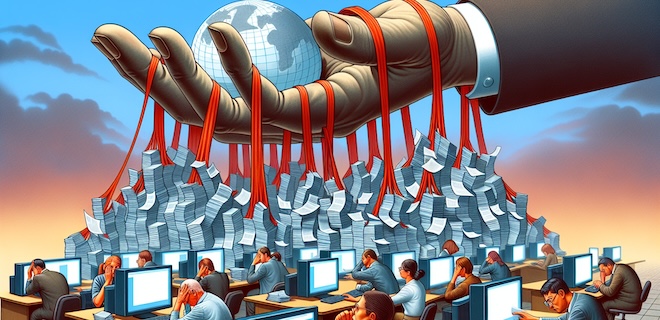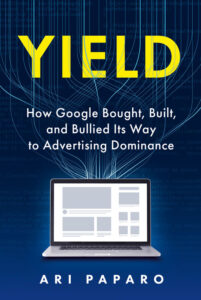
A Q&A with Ari Paparo, Author of “Yield,” and CEO of Marketecture Media.
For three weeks, Marketecture Media CEO, veteran ad tech executive and podcaster Ari Paparo sat in a Virginia courtroom listening to testimony in the US Department of Justice’s landmark antitrust case against Google.
What he heard wasn’t just a technical story about header bidding or auction mechanics; it was a human story, filled with frustration, manipulation and missed opportunity.
That experience inspired him to write “Yield: How Google Dominated the Ads That Made the Web.” AdMonsters caught up with Ari to talk about the book, the market forces behind the trial and what’s at stake for the future of advertising.
AdMonsters: Why did you write this book?
 Ari Paparo: I decided to write the book while I was at the trial in Virginia. I sat there for three weeks in the pews listening to the testimony of both the Google witnesses and the DOJ witnesses, and I found that they were bringing to life stories about the evolution of media and advertising over this 15-20-year time period.
Ari Paparo: I decided to write the book while I was at the trial in Virginia. I sat there for three weeks in the pews listening to the testimony of both the Google witnesses and the DOJ witnesses, and I found that they were bringing to life stories about the evolution of media and advertising over this 15-20-year time period.
The stories were really compelling. They weren’t just, “Here’s how header bidding works” or “Here’s why yield matters.” It was, “They gaslit me,” “They lied to me,” “I felt powerless”—those sorts of conversations. And I thought this would be an interesting journalistic account of a complex industry. I wanted to bring it to life.
AdMonsters: Who do you want to read the book?
AP: I wrote this book for a mainstream business audience, people who are interested in advertising, particularly Google and the structural power of Big Tech companies. This isn’t an ad tech-centric book. I think certainly anyone who attends an AdMonsters event or reads your newsletter will be interested in the subject matter, but I’d love it if those people could also give it to their spouses or colleagues who aren’t in the weeds of ad tech and have them find it entertaining and interesting.
AdMonsters: What do you hope readers take away from the book? What do you want them to think when they walk away from “Yield”?
AP: I think the story of the financialization of advertising is a bit of a cautionary tale. It’s obviously a better way to buy and sell advertising than the old, traditional way, but it opened up Pandora’s box. It brought the relationships between advertisers and publishers and technology to a totally different place than anyone expected.
Google did what Google does: it used technology to innovate and leverage its advantages in data and scale. That’s really the story here. I don’t want people to walk away thinking, “Google is a bad company” or “Google is an evil company,” because I don’t think that’s what I’m saying. I don’t think they acted entirely out of malice. They may have been a bit arrogant and made some mistakes, but it’s a more nuanced conversation.

AdMonsters: Not an evil company, but you do reference internal schemes, Bernanke and Project Poirot, in the book. What were those programs, and what did they reveal about Google’s behavior?
AP: Google entered the market for display advertising through the DoubleClick acquisition, but they weren’t in the driver’s seat at first. They had some interesting ass
ets, but they were nowhere near the level of Yahoo or MSN at the time. Back then, people talked about “the Big Three” as AOL, Yahoo and MSN, which is hard to believe now.
To Google’s credit, they executed well. They built the exchange and their ad network (GDN), and by around 2013, they found themselves as the buyer, seller and measurement partner for a significant share of internet advertising. That position was almost too good to be true. And maybe too tempting.
That’s when you start to see some of the more questionable behavior, with programs like Bernanke, dynamic rev share and Project Poirot. Those were run by a group called the gTrade team, which was modeled after the Ads Quality team used to increase revenue from Google’s search products.
The problem is, with Search, Google owns both the buy side and the sell side, so tweaking things to increase revenue wasn’t ethically complicated. But when you’re sitting between an advertiser and a publisher, both of whom are supposed to be your clients, and you start changing the auction mechanics, putting your finger on the scale, that’s different.
At that point, you’re potentially not acting in your clients’ best interests and maybe even breaching contracts. That’s what the Texas lawsuit is focused on. The DOJ lawsuit didn’t address those programs, but the behavior they reflect—what I call the “hand in the cookie jar” era—looks pretty bad in retrospect.
AdMonsters: Why didn’t rivals like Microsoft or AT&T stop Google?
AP: They all had the same problem: They were losing consumers. And consumers are the lifeblood of any media business. Unlike Google, they didn’t take the aggressive step of replacing their owned-and-operated audiences with a broader network strategy.
Google had a funny advantage. They didn’t have any significant owned-and-operated display properties when they acquired DoubleClick. YouTube was still small and not yet running ads, and their big products like Search and Gmail were mostly text. When Google entered the display market, they were completely network-focused. They wanted to get their tags on every page and monetize the entire web.
Yahoo, on the other hand, had so much owned-and-operated inventory that all of its ad tech efforts, such as its Right Media acquisition, were redirected to monetize their own properties more efficiently. But those properties were in long-term decline.
So, as Yahoo Mail lost users to Gmail and MSN faded because people stopped using Microsoft’s browsers, their core assets eroded. And they didn’t invest in a strategy beyond that. The only partial exception was AOL’s Advertising.com business, which retained value and helped justify AOL’s $4 billion sale to Verizon. But, overall, these companies missed the bigger shift.
AdMonsters: What’s at stake for journalism if the current system stays intact?
AP: I think this is where some of the criticism of the whole process comes in, because there’s not much here, going forward, that’s going to fundamentally change the decline in ad-supported journalism.
You could argue it’s too little, too late, or maybe just not relevant. The real problems for journalism today are more about consumer behavior—people moving to social, to apps, to CTV. That’s what’s eroding the traditional model. The ad-stack monopoly doesn’t help, and you can make the case that journalism would be slightly better off if the ad-stack monopoly hadn’t existed, but it’s a secondary thing.
AdMonsters: How has Google’s dominance shaped which types of media survive? What innovation might we have lost along the way?
AP: That’s a hard question to answer directly. I think the biggest indictment here is that Google’s monopoly made it very hard for other potential entrants to operate in the market. And that leaves us with a big unknown: What could the world have looked like if more entrepreneurs or other tech companies had been able to compete freely in the open web?
One of the most interesting things I heard during the trial was that internal Facebook documents talked about how the web was an unattractive market because Google stood in the middle. They literally said things like—I’m paraphrasing here—“No matter what we do, we have to go through Google to get to web inventory.” That discouraged their investment.
You can imagine an alternate world where Facebook Audience Network became a real contender. But it wasn’t because of that.
“Yield: How Google Bought, Built and Bullied Its Way to Advertising Dominance” is available on Amazon.